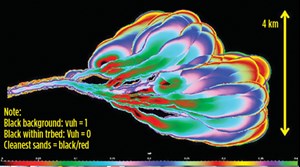What's New in Exploration
These days, it’s popular to predict doom and gloom, then say it isn’t so. Gloom means way lower than $45 oil. However, will price matter, when costs can be kept down by removing more payroll from E&P firms? Is it a dream or a nightmare? Just how low can layoffs go before a collapse? Thus, the great new hope for cost elimination, and recovery from human resource drain, is smarter artificial intelligence (A.I.).

Latest on A.I. Read this headline: A.I. APOCALYPSE: How artificial superintelligence will ‘eliminate’ humans... This author is not a Star Wars fan, where our future is shown in a symbiotic, but violent relationship with clunky A.I. robots. We have a way to go before vindictive robots, who look like Arnold Schwarzenegger, take over, as exemplified by this item from The Wall Street Journal: Self-Driving Program Hits Another Pothole... Yet, use of intelligent “thinking” machines has been going on for some time in exploration, production, and drilling management.
What is new is recognition that A.I., not just more automation, can be used to accomplish complex “thinking” tasks, with or without humans. SPE is now forming active interaction with this strongly emerging technology. SPE is calling its latest interest committee, “Unmanned Systems” or USYS, pronounced, “uses.”
Confirmation comes from a personal communication from Ed Tovar, president at Austin, Texas-based InTechSys:
“I am pleased to announce that on Monday, 27 March 2017, we received notification that SPE/USYS Technical Section has been officially approved by the Society of Petroleum Engineers board. SPE/USYS Technical Section will be led by Daniel De Clute-Melancon/Weatherford; Susan Nash, Ph.D./AAPG; Chris Mentzer/SwRI; Trey Mebane/Chasm Vision, LLC; Shasta Foy/SPE and me. For more information, consult this link: https://www.spe.org/en/ogf/ogf-article-detail/?art=2870.
Certainly, you don’t need to be a Trekkie to know that NASA was using an HP 42 manual calculator as its onboard computer in the early days of the Space Shuttle. Thirty years later, NASA uses A.I. extensively for space exploration and intends to develop a lot more. Did you see the recent U.S. Air Force spacecraft that returned, unmanned, from a two-year mission around our planet? Does the military have more on complex A.I. machines than the oil and gas industry?
Seismic-related usage. At this year’s OTC in Houston, it was reported that Paradigm and Nervana are working on seismic interpretation software that behaves as A.I., to relieve interpreters from repetitive tasks. Sounds useful. This ends up making management think they don’t need interpreters. You and I have seen this level of planning, every time new technology was deployed. How many times did we hear that seismic amplitudes, including bright spots, were “the answer.” There was a shortage of interpreters. First to use amplitudes, then later fired because they did use amplitudes. Many dry holes later, we meant acoustic AVO. No, more dry holes later, we meant seismic elastic parameters and 3-component vector analysis. Meanwhile, some guy with a pressurized water truck and an analog pressure gauge revolutionized our entire understanding of permeability and production by merely breaking apart some of the tight rocks in a horizontal wellbore.
I helped SEG/SEAM on the SEAM Phase One project for RPSEA. Then, becoming both a pain and a prophet, I created the SEAM Pore Pressure project, funded initially by DOE/RPSEA. It was obvious to me, post-Macondo, that accurate pore pressure prediction from seismic would be a safety tool and an improvement to exploration. However, the synthetic marine data sets were so enormous, that we had to use limited A.I. in computing simulations and derivatives. Real humans set the limitations, but the billions of decisions for the calculations were controlled by A.I. smart machines.
It became intuitive for explorationists to want to use those first pore pressure results to follow seismic data changes that could result during field development, that is 4D, better called Time Lapse seismic. Volumes of PP4D data are now available from SEAM to partners and will be released later to the public at a modest fee. As SEG noted, “The PP4D project focused on understanding the evolution of pore pressure during production, using time-lapse geophysical data and reservoir characterization.”
Invention of the PC, DOS, GUI’s, cell phones, internet, and social media was all called A.I. at some point. More toys mean less time with humans. We quickly forget the cost/benefit of each tech tool. “Super A.I.” will be no different.
When I was a geo-puppy, I mapped groundwater resources in the Black Hills, using paper Army 1:250k maps [only a few 7.5-minute quad sheets existed], a Dodge Power Wagon and a poorly mannered horse. There were no cell phones or PC’s in those days, so I would call HQ from time to time. My boss transferred me back to Cheyenne, Wyo., because he knew I had been with GSI-TI in Dallas and probably understood computers. He had just purchased one for the office, a desktop HP 9830A using BASIC. I should not have called in that day to report. ![]()

- Advancing offshore decarbonization through electrification of FPSOs (March 2024)
- The reserves replacement dilemma: Can intelligent digital technologies fill the supply gap? (March 2024)
- Subsea technology- Corrosion monitoring: From failure to success (February 2024)
- Prices and governmental policies combine to stymie Canadian upstream growth (February 2024)
- U.S. producing gas wells increase despite low prices (February 2024)
- U.S. drilling: More of the same expected (February 2024)
- Applying ultra-deep LWD resistivity technology successfully in a SAGD operation (May 2019)
- Adoption of wireless intelligent completions advances (May 2019)
- Majors double down as takeaway crunch eases (April 2019)
- What’s new in well logging and formation evaluation (April 2019)
- Qualification of a 20,000-psi subsea BOP: A collaborative approach (February 2019)
- ConocoPhillips’ Greg Leveille sees rapid trajectory of technical advancement continuing (February 2019)


